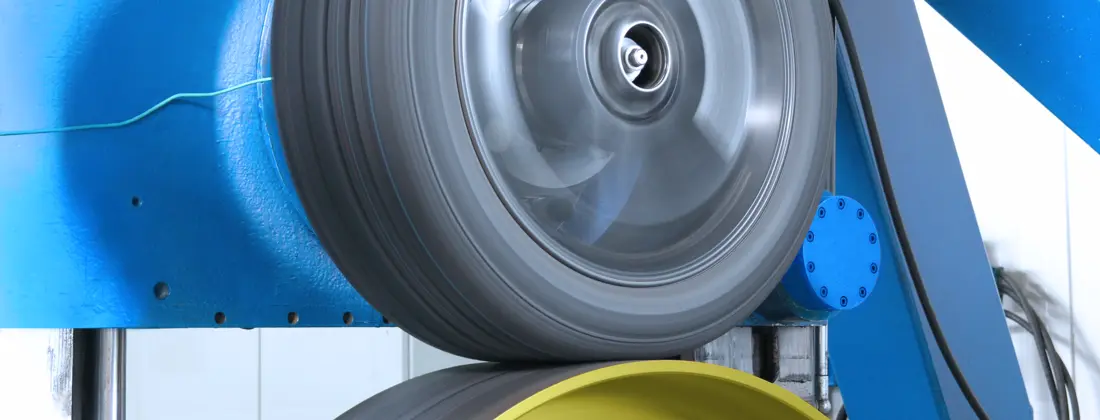ASTM F403 Passenger Car Tyre Hydroplaning Resistance Testing
The ASTM F403 standard is designed to evaluate the hydroplaning resistance of passenger car tyres under controlled laboratory conditions. This service addresses a critical safety concern for automotive manufacturers and tyre suppliers by ensuring that tyres perform reliably in wet road conditions, which can significantly impact vehicle stability and driver control.
Hydroplaning occurs when a layer of water builds up between the tyre tread and the road surface, causing the tyre to lose contact with the ground. This phenomenon is particularly dangerous at high speeds on wet roads, as it reduces the tyre's ability to grip the road effectively. ASTM F403 provides a standardized method for measuring how well tyres can maintain their grip under these conditions.
The testing procedure involves placing a rotating tyre onto a hydroplaning test rig where it is subjected to a controlled water depth and velocity. The goal is to determine the critical speed at which hydroplaning begins, known as the hydroplaning speed. This value helps manufacturers understand how their tyres will perform in real-world scenarios.
During testing, various factors such as tyre pressure, inflation temperature, and wheel alignment are closely monitored and controlled to ensure consistent results. The test rig is calibrated according to ASTM F403 specifications to guarantee accuracy and repeatability.
The importance of this service lies in its contribution to improving road safety. By ensuring that tyres meet the hydroplaning resistance criteria specified in ASTM F403, manufacturers can help prevent accidents caused by loss of vehicle control due to wet weather conditions. This standard is widely recognized within the automotive industry and is often a requirement for product certification.
In addition to its role in enhancing safety, ASTM F403 also supports ongoing research into tyre performance and development of new materials and designs that can improve hydroplaning resistance. The results from these tests are used by manufacturers to make informed decisions about their product design and manufacturing processes.
For quality managers and compliance officers responsible for ensuring that products meet regulatory standards, this service is essential in maintaining a robust quality assurance program. It also supports the work of R&D engineers who rely on accurate test data to innovate and improve tyre performance.
Scope and Methodology
The ASTM F403 standard specifies the procedure for determining the critical hydroplaning speed of passenger car tyres. The scope includes a detailed description of the apparatus required, the specimen preparation process, and the testing methodology.
- Apparatus: The test rig used in this method must meet specific criteria outlined in ASTM F403 to ensure accuracy and repeatability. These include:
- A hydroplaning test rig
- A water supply system with a controllable flow rate
- A means of measuring the speed of rotation of the tyre
- Temperature control for both the tyre and the surrounding environment
- Specimen Preparation: Prior to testing, tyres undergo a thorough cleaning process to remove any contaminants that could affect test results. The inflation pressure is set according to manufacturer specifications.
- Testing Methodology: The tyre is mounted on the hydroplaning rig and rotated at progressively higher speeds while a controlled amount of water is introduced under the tyre. The critical speed at which the tyre begins to lose contact with the rig's surface (hydroplaning) is recorded.
The results are then analyzed using statistical methods to ensure reliability and accuracy. This comprehensive approach ensures that the test data accurately reflects real-world driving conditions, providing valuable insights into tyre performance under hydroplaning scenarios.
International Acceptance and Recognition
The ASTM F403 standard has gained significant recognition within both national and international standards bodies. It is widely accepted by regulatory authorities worldwide as a reliable method for assessing tyre hydroplaning resistance, contributing to the global effort towards enhancing road safety.
This service plays a crucial role in ensuring compliance with various international regulations such as:
- ISO 28303: This standard provides guidelines for testing the wet grip of tyres, which is closely related to hydroplaning resistance. ASTM F403 complements ISO 28303 by focusing specifically on hydroplaning.
- EN 12678: This European standard specifies requirements and test methods for tyres intended for use with vehicles. ASTM F403 is considered a valuable tool in meeting the stringent requirements outlined in EN 12678.
The acceptance of ASTM F403 by these bodies underscores its importance in the global automotive industry. Manufacturers who adhere to this standard can demonstrate their commitment to safety and regulatory compliance, thereby gaining a competitive edge in the market.
Environmental and Sustainability Contributions
The ASTM F403 service contributes positively to environmental sustainability by promoting safer driving practices that reduce accident risks. Safer roads directly translate into fewer accidents, which in turn leads to reduced carbon emissions from vehicles involved in crashes or responding to emergencies.
- Energy Efficiency: By improving tyre performance under hydroplaning conditions, the service helps ensure that tyres operate at optimal efficiency, reducing fuel consumption and associated emissions.
- Better Utilization of Resources: Safer driving means fewer accidents, which can lead to better utilization of road infrastructure. This results in more efficient transport operations and reduced resource depletion.
The service also supports the development of tyres that are more resilient under challenging conditions, potentially leading to longer tyre lifespans and less frequent replacements. This extends the useful life of each tyre, further reducing environmental impact by decreasing the amount of waste generated from discarded tyres.





